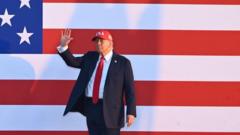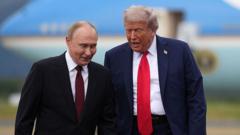With US debt now at an alarming $37 trillion, analysts express concerns over the viability of ongoing borrowing practices. The implications of this debt could include drastic government spending cuts, increased taxes, or potential defaults, raising questions about the future of the dollar and the global financial system.
Analyzing the Implications of the $37 Trillion US Debt: Should We Be Alarmed?

Analyzing the Implications of the $37 Trillion US Debt: Should We Be Alarmed?
As the US debt reaches $37 trillion, experts weigh in on the sustainability of American borrowing and its potential impacts on the economy.
As the United States debt surges to an unprecedented $37 trillion, critical voices are emerging regarding the potential ramifications of this fiscal reality. Following the recent passage of former President Donald Trump’s controversial Big Beautiful Budget Bill, which is projected to escalate national debt by at least $3 trillion, financial experts and economists are questioning the sustainability of such borrowing practices.
Criticism of the plan extends beyond political circles, with figures like Elon Musk condemning it as a “disgusting abomination.” The increasing debt is causing unease over the extent to which foreign entities will continue lending to the United States, reflected in a decline in the dollar's value and an uptick in interest rates expected by investors. For context, in 2023 alone, the dollar has depreciated by 10% against the British pound and 15% against the euro.
Interestingly, while overall borrowing costs have stabilized, the widening gap between long-term and short-term interest rates—known as the yield curve—indicates growing skepticism about America's long-term fiscal health. This phenomenon stands in contrast to the more gradual reduction of interest rates by the US compared to the EU and UK, which usually bolsters the dollar’s strength.
Financial titan Ray Dalio asserts that the US financial situation is at a critical juncture, warning that unchecked debt could lead to annual repayments of $10 trillion. “If this is not dealt with now, the debts will build up to levels where they can't be managed without great trauma,” Dalio cautions.
At its most severe, potential solutions include drastic spending cuts, increased taxation, or even a default scenario. While the recent budget introduced slight expenditure reductions, it has predominantly favored tax cuts, diverging from the path Dalio suggests could mitigate future crises by lowering the budget deficit from 6% to 3%.
Historically, the US Federal Reserve has intervened by printing money to acquire government debt, as seen during the 2008 financial crisis. However, this approach risks igniting inflation and exacerbating wealth inequality, benefitting asset holders at the expense of wage earners.
The likelihood of these dire outcomes remains low for now. Despite ongoing concerns, the dollar still enjoys a quasi-monopoly status in global finance. Economist Mohamed El-Erian noted the challenges that countries face in reducing their reliance on the dollar, characterizing it as the “cleanest dirty shirt” in a world with limited alternatives.
Notably, discussions surrounding the future of US debt and the dollar's status are occurring at high-level economic forums. Indicators from the Bank of England suggest that while current concerns over debt levels are recognized, the dollar is not fundamentally under threat.
To comprehend the magnitude of the US debt, consider this: amassing $37 trillion would take someone saving $1 million daily an astonishing 100,000 years. Economically, however, assessing debt relative to national income provides a more pertinent perspective. With an annual output nearing $25 trillion, the US’s debt-to-income ratio, although high, is less severe than that of Japan or Italy, buoyed by the innovative potential of the American economy.
As these debates swirl, the timeless warnings about the dollar's stability endure. Historical texts question its reserve currency status, yet the currency remains resilient—perhaps a testament to the intricate web of economic factors that underpin global finance.



















